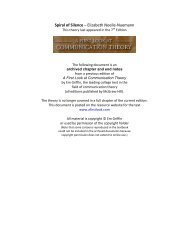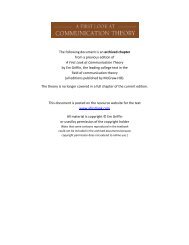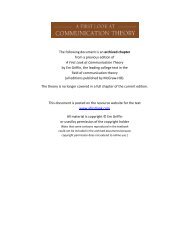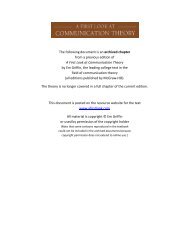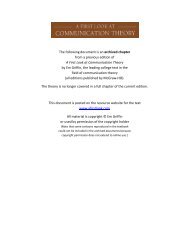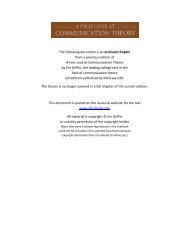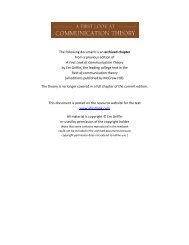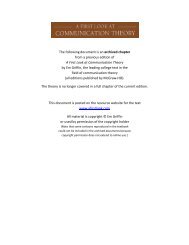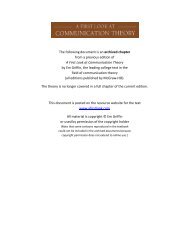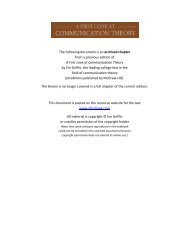Adaptive Structuration Theory of Marshall Scott Poole
Adaptive Structuration Theory of Marshall Scott Poole
Adaptive Structuration Theory of Marshall Scott Poole
You also want an ePaper? Increase the reach of your titles
YUMPU automatically turns print PDFs into web optimized ePapers that Google loves.
Interpenetration <strong>of</strong><br />
structures<br />
Unnoticed change over<br />
time as reproduced structures<br />
affect each other.<br />
CHA PTER 18: ADAPTlVE STRUCTURATlON THEORY<br />
The book contains a Oilbert cartoon here.<br />
Permission to reproduce the cartoon was<br />
granted for the original publication only and<br />
does not include reproduction in the online archive.<br />
243<br />
Stability. You can't know from a few class meetings whether the rules<br />
and resources you've used so far w ill be employed the same way in the futu re.<br />
My guess is that consensus seeking among studen ts and a relative independ<br />
ence vis-a-vis the im: tru ctor w ill continue to be enacted and be group norms<br />
even after he rejoins the class. You've already developed a sense <strong>of</strong> camaraderie,<br />
but it w ill survive only if spokespeople like Josh and Megan confidently<br />
instruct your instructor on the decisions you've made, and the rest <strong>of</strong> you back<br />
them up. Because structures exist only when they are put in to practice-a<br />
u se-it-or-Iose-it structurational principle-a united front can reproduce the<br />
group's rules and resources. Members' continual use <strong>of</strong> the same rules and<br />
resources can form layers <strong>of</strong> solidified group structures m uch like sedimented<br />
rock.<br />
Change. Reproduction does not necessarily mean replication. Even when<br />
a group appears stable, the rules and resources that members use can change<br />
gradually over time through the process <strong>Poole</strong> calls in terpenetration <strong>of</strong> structures.<br />
Since any group action d raws upon multiple rules and resources, <strong>Poole</strong>'s<br />
phrase helps us picture how one structure might affect (or infect) the other.<br />
Think again <strong>of</strong> the way your class incorporates voting into a consensus structu<br />
re. If no one ever casts a negative vote because agreement has already been<br />
reached , the consensus structure has m ediated the meaning <strong>of</strong> the voting<br />
structure.<br />
Although your class was able to create a w ay for voting and consensus to<br />
coexist, <strong>Poole</strong> notes that there are times w hen group structures are in direct<br />
contradiction, each undermining the other. This may be the case with the pr<strong>of</strong>essor's<br />
knowledge <strong>of</strong> communication theory and the students' sense <strong>of</strong> autonomy.<br />
In his brief appearance on the first day <strong>of</strong> class, the pr<strong>of</strong> relinquished his<br />
authority to structure the course but expressed his desire to serve as a resource<br />
for the group. Yet when he returns, you may find yourselves hesitant to ask<br />
questions. You w ant to tap his wealth <strong>of</strong> knowledge but fear falling back into<br />
the dependency <strong>of</strong> the traditional teacher-student relationship. If you don't<br />
d raw on his knowledge, he will cease to be a resource for the group. Rules and<br />
resources survive and thrive only as group members actively put them in<br />
play.



